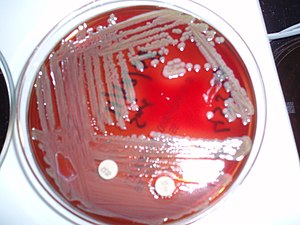Flavobacteriaceae
| Flavobacteriaceae | ||||||||||
|---|---|---|---|---|---|---|---|---|---|---|

Elizabethkingia meningoseptica : colonies on blood agar plates |
||||||||||
| Systematics | ||||||||||
|
||||||||||
| Scientific name | ||||||||||
| Flavobacteriaceae | ||||||||||
| Reichenbach et al. 1992 |
The Flavobacteriaceae are a family of bacteria. The type genus is Flavobacterium .
features
The gram test is negative. The cells are rod-shaped. Some species can form filamentous cells. They are short or moderately elongated. Some form helical cells. There are immobile or slidingly movable species.
Some species are obligatorily aerobic and also obligatorily anaerobic . Colonies often have a yellow color, formed by the pigment flexirubin , hence the name (flavus = Latin yellow). Some representatives are cold-loving ( psychrophil ), examples are Flavobacterium psychrophilum , the cause of columnar disease in fish, as well as types of Polaribacter and Psychroflexus .
Pathogenicity
There are only a few pathogenic (disease-causing) species in the Flavobacteriaceae family . Most species are free in the environment. The pathogenic representatives include z. B. Bergeyella zoohelcum , Myroides odoratus and Myroides odartimismus and Chryseobacterium indolgens . Others are also pathogenic to some animal species. Thus causing Flavobacterium branchiophilum the bacterial gill disease of trout . Elizabethkingia meningoseptica (formerly known as Flavobacterium meningoseptica ) can cause meningitis in young children and infants.
Occurrence
Species of the Flavobacteriaceae occur in the soil and in fresh water, brackish water or in sea water. Some have been found in food and milk. Some, as yet unidentified members of the family inhabit the digestive tract of insects , others live within cells (intracellularly) of amoeba. Many species of the genus Capnocytophaga occur in the mouths of humans, some also in the mouths of dogs and cats.
Systematics
A selection of genera follows:
- Actibacter Kim et al., 2008
- Aequorivita Bowman and Nichols, 2002
- Apibacter Kwong & Moran, 2013
- Bergeyella Vandamme et al., 1994
- Bizionia Nedashkovskaya et al., 2005
-
Capnocytophaga Leadbetter et al., 1982
- Capnocytophaga canimorsus Brenner et al., 1990
- Chryseobacterium Vandamme et al., 1994
- Dokdonia Yoon et al., 2005
- Elizabethkingia Kim et al., 2005
- Flavobacterium Bergey et al., 1923
- Gaetbulibacter Jung et al., 2005
- Hyunsoonleella Yoon et al., 2010
- Maribacter Nedashkovskaya et al., 2004
- Myroides Vancanneyt et al., 1996
- Polaribacter Gosink et al., 1998
- Psychroflexus Bowman et al., 1999
- Zeaxanthinibacter Asker et al., 2007
Individual evidence
- ↑ JP Euzéby: List of Prokaryotic Names with Standing in Nomenclature - Flavobacteriaceae (as of June 20, 2019)
- ↑ Waldan K. Kwong, Nancy A. Moran : Apibacter adventoris gen. Nov., Sp. nov., a member of the phylum Bacteroidetes isolated from honey bees. International Journal of Systematic and Evolutionary Microbiology 66, 2016; Pp. 1323-1329. doi : 10.1099 / ijsem.0.000882 .
literature
- Noel R. Krieg et al. (Ed.): Bergey's Manual of Systematic Bacteriology . 2nd edition, Volume 4: The Bacteroidetes, Spirochaetes, Tenericutes (Mollicutes), Acidobacteria, Fibrobacteres, Fusobacteria, Dictyoglomi, Gemmatimonadetes, Lentisphaerae, Verrucomicrobia, Chlamydiae, and Planctomycetes . Springer, New York 2010, ISBN 978-0-387-68572-4 , pp. 106-314 .
- Gholamreza Darai among others: Lexicon of infectious diseases in humans: pathogens, symptoms, diagnosis, therapy and prophylaxis . Springer, New York 2003, ISBN 978-3-540-44168-7 , pp. 311 .
- Michael T. Madigan, John M. Martinko, Jack Parker: Brock - Microbiology . 11th edition. Pearson Studium, Munich 2009, ISBN 978-3-8273-7358-8 , pp. 454 .